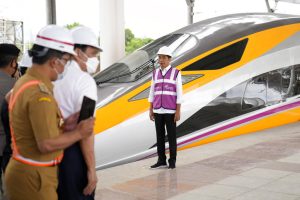Indonesia is preparing to start Southeast Asia’s first high-speed rail service that will cut travel time between two cities from the current three hours to about 40 minutes.
The railway line, which connects Indonesia’s capital Jakarta and Bandung, the heavily populated capital of West Java province, is part of China’s Belt and Road infrastructure initiative.
As the Jakarta-Bandung portion of the rail project approached 90 percent completion, Indonesia’s President Joko Widodo on Thursday visited Bandung’s Tegalluar station — one of the railway’s four stations — where eight train cars and an inspection train that arrived from China in early September were parked.
“We hope with the Jakarta-Bandung high-speed train, the mobility of goods and people can be faster and improved, and our competitiveness will also be stronger,” Widodo told reporters during the visit. Widodo also expected the bullet train to benefit other sectors.
Earlier reports said Widodo would invite his Chinese counterpart Xi Jinping to ride on the China-made bullet train after the Group of 20 biggest economies summit in Bali next month. However, Widodo told reporters Thursday, the plan is still being discussed with Xi, and “it is still not final yet.”
The train cars were designed and built by China’s CRRC Qingdao Sifang railway company. September’s delivery was CRRC’s first export of high-speed trains in its 11-train contract for KCIC400AF eight-car trains and one KCIC400AF-CIT inspection train. The contract, worth $364.5 million, was awarded to CRRC in April 2017.
The rail line construction that began in 2016 was originally expected to start operating in 2019 but was delayed until June 2023 due to disputes that involved land purchases and environmental issues.
The 142.3-kilometer railway worth $7.8 billion is being constructed by PT Kereta Cepat Indonesia-China, or PT KCIC, a joint venture between an Indonesian consortium of four state-owned companies and China Railway International Co. Ltd. The joint venture said the trains will be the fastest in Southeast Asia.
The CRRC claimed that the KCIC400AF train can reach speeds up to 350 kilometers per hour, pass curves with a minimum radius of 150 meters, and is equipped with electric motors, each with a power of 625,000 watts. The cars will be divided into three classes: VIP, first and second, and several cars with large spaces between seats will be allocated for passengers with limited mobility.
The manufacturer said the trains are specifically modified to adapt to Indonesia’s tropical climate, and are equipped with an improved security system that has the ability to track earthquakes, floods and other emergency conditions. The length of the eight-car train is 208.9 meters.
The rail deal was signed in October 2015 after Indonesia selected China over Japan in competitive bidding, and was financed by a loan from the China Development Bank for 75 percent. The remaining 25 percent is the consortium’s own funds.
The project is part of a planned 750-kilometer high-speed train line that would cut across four provinces on the main island of Java and end in the country’s second-largest city of Surabaya.
Infrastructure improvement, Widodo’s signature policy, helped him win a second term in the 2019 elections.
Jakarta’s subway — a Japan-backed venture — was inaugurated in 2019 as part of the capital’s efforts to ease traffic congestion. Its second phase will soon be completed and the United Kingdom and Japan have offered the country soft loans for its third phase, said transportation minister Budi Karya Sumadi.
The government has completed other rail projects, including light-rail transit services in Palembang and Jakarta, while five other cities, including on Indonesia’s tourist island of Bali, have LRT plans in the pipeline.
Associated Press writer Niniek Karmini in Jakarta, Indonesia, contributed to this report.

































